Major Findings
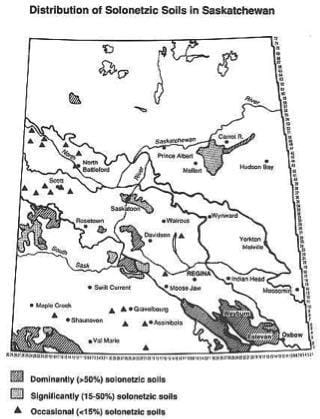
(from Stonehouse, 1991)
- Deep tillage is not a generally recommended farm practice in Saskatchewan;
- Deep tillage should be carried out only when there is a hardpan layer that restricts roots and water to a shallow soil depth;
- Most hardpan soils found in Saskatchewan are Solonetzic soils;
- Deep plowing is considered a long term improvement of Solonetzic soils, but is expensive;
- Deep ripping is considerably less expensive than deep plowing, but may have to be repeated;
- Deep plowing is more effective than deep ripping on Solonetzic soils in the Brown and Dark Brown soil zones;
- Deep ripping Solonetzic soils in the Black and Gray soil zones works adequately and is less expensive than deep plowing; and
- Subsoiling that produces minimum surface disturbance but with lifting action at depth can be beneficial in loosening long-term wheel traffic compacted areas that are identified in a field.
Penetrometers provide a measurement of relative soil strength. Soil moisture content greatly influences soil strength. Do not mistake dry soils for compacted soils.
Why Deep Till Soils
Deep tillage is not a generally recommended farm practice in Saskatchewan.
Deep tillage should never be carried out on saline soils because it increases evaporation and could bring salts from the subsoil to the surface. Neither should soils prone to erosion be deep tilled, since deep tilling can increase the likelihood of erosion.
On most soils deep tillage is of little benefit and may result in excessive loss of soil moisture.
Deep tillage can improve crop production on what are often referred to as hardpan soils. Hardpan soils have a dense layer which has few, if any, large pores such as cracks and old root channels. Large soil pores are important for good water infiltration and root growth. When there are no (or only a few) large soil pores the infiltration of rainfall and snow melt is poor. This results in water ponding at the soil surface and/or more water runoff, and thus, poor moisture conservation. Furthermore, the volume of soil that the plant roots can exploit for moisture and nutrients is restricted by the hardpan layer. Moisture and nutrient stresses of crops commonly occur in hardpan soils, particularly in dry years.
Hardpan Soil
There are two types of hardpan soils where deep tillage is considered beneficial: compacted soils and Solonetzic soils.
Compacted Soils occur when the stress (weight) on the soil from farm equipment exceeds the ability of the soil to support that stress. The soil is "squeezed" into a smaller volume (i.e. compacted) at the expense of the larger soil pores. Soil compaction is greatest when the soil moisture content is high because water acts as a lubricant allowing soil particles to slide past each other as the soil is compressed. For this reason, soil compaction is a greater problem in wetter environments such as Europe, the southeastern USA, and to a lesser extent the northern part of the Saskatchewan grain belt.
There are three types of soil compaction. Shallow compaction is limited to the upper 10 cm (4 inches) of soil. Shallow soil compaction or firming of the seed bed often will be beneficial in dry years. Shallow soil compaction is of short duration since the soil will loosen as it undergoes wetting and drying, freezing and thawing.
A second type of compaction is plow pan or tillage pan formation, in which a dense layer forms just below the depth of normal tillage. This type of compaction has been observed where one-way discs and sweeps are used extensively. Tillage pan is seldom seen as most of Saskatchewan cropland is under zero-tillage.
The third type of compaction is deep compaction in the wheel tracks of heavy farm equipment under wet soil conditions. Deep compaction extends below the depth of normal tillage. Unlike surface compaction, deep compaction depends on the axle load and therefore is similar for single and dual-tired equipment. Equipment today use flotation tires and track systems to minimize the pressure per square inch applied to the soil, thus lessening compaction pressure.
Tillage pans and deeper compaction in wheel tracks are related and are a concern because they can persist longer.
Solonetzic or burnout soils have a very dense soil layer which is high in clay and sodium, that is referred to as the Bnt horizon or solonetzic layer. The solonetzic layer can start as shallow as 10 cm (4 inches) and may extend as deep as 75 cm (30 inches). The solonetzic layer is very hard when dry and restricts water movement when wet. Topsoil quality may also be poor, resulting in crusting problems and increased susceptibility to soil erosion. The soil below the solonetzic layer (Csk horizon) is often high in calcium and magnesium salts.
There are about 1.8 million ha (4.5 million acres) of Solonetzic soils in Saskatchewan, occurring primarily in the Brown and Dark Brown soil zones. In some areas the soils are dominated by Solonetzic soils, which usually indicates that the soils were developed from sodium-rich parent materials. In other areas, Solonetzic soils are found in close association with "better" quality prairie soils (i.e. Chernozemic soils) and in these cases the Solonetzic soils usually occupy the lower slope positions.
Management of Solonetzic soils requires that special attention be paid to use of flotation tires or track, timing of tillage, and seeding operations with respect to moisture conditions. When the soil is too wet tillage implements are unable to work. Conversely, when the soil is too dry tillage implements have difficulty penetrating the soil and cause hard lumps when they do.
Most hardpan soils in Saskatchewan are Solonetzic soils rather than compacted soils. The mechanical soil-loosening techniques discussed in this bulletin (deep plowing and deep ripping) apply mainly to Solonetzic soils. However, deep ripping can also benefit compacted soils.
Apart from tillage, concerns about high soil strength and compaction may be addressed through cropping practices that increase root extension throughout the soil profile and enhance soil organic matter content. Examples are direct seeding, growing forages and deep rooted crops, and adding manure and other organic amendments as well as use of modern flotation tires and track.
Identifying a Hardpan Soil
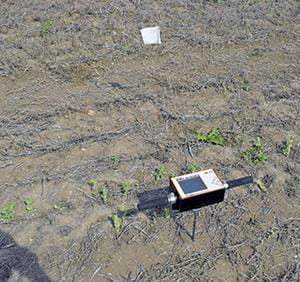
of pushing the penetrometer, a rod,
into the soil.
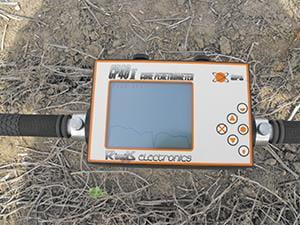
the resistance is shown on the graph on the instrument
screen. This indicates where the compaction or hard
pan layer is located within the soil profile.
Symptoms that indicate hardpan soils:
- Water ponding in the field following rainfall or melting snow;
- Uneven crop growth;
- Poor penetration of tillage equipment and/or high draft (horsepower) requirement; and
- Plant roots growing sideways after they reach a certain depth in the soil.
In some cases these symptoms may indicate other soil and/or plant problems (such as low soil fertility levels), and thus it must first be determined if the soil is actually a hardpan soil.
A hardpan soil may be identified by on-site field inspections. One method involves pushing a small-diameter steel rod into the soil to a depth of 60 cm (2 feet). Another method involves digging a small hole (the width of a shovel extending down to 60 cm (2 feet) and pushing a knife blade into the side of the pit at various depths. A hardpan layer will make it difficult to push the rod or knife blade into the soil. The rod or blade will then stick when trying to removed it. Soil samples sent to a soil testing laboratory for chemical analysis will confirm whether or not the soil is Solonetzic.
Another method to determine whether a hardpan or compaction is present is to use a penetrometer. A penetrometer is an instrument that measures soil resistance to penetration, often termed "soil strength." Mechanical and electronic cone penetrometers are available. Moisture content greatly influences soil strength. Drier soils have greater penetration resistance, all other things being equal. Do not confuse the effect of dry conditions with compaction.
What is Deep Tillage?
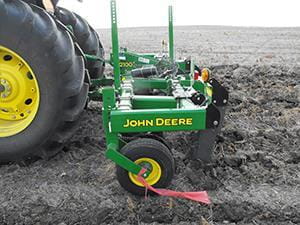
or hard pan by cutting channels and do some
mixing to allow water to infiltrate and crop
roots grow deeper in the soil profile.
Deep rippers are subsoilers with long shanks and a foot on the bottom to create a lifting action. They loosen the subsoil but result in little surface soil disturbance and mixing. Deep plowing on the other hand creates considerable surface and subsurface disturbance and mixing.
For maximum soil shattering, deep tillage operations should be carried out when the soils are dry.
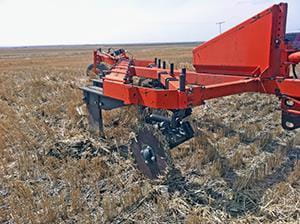
or hard pan below the surface while minimizing
soil surface disturbance.
The cost of deep plowing is expensive. The cost of deep ripping is about half or less than the cost of deep plowing. Generally, the greater the severity of the hardpan, the greater is the cost of deep plowing or deep ripping and, usually, the greater the benefits in terms of increased crop production.
Deep Tillage and Crop Production on Solonetzic Soils
Producers should determine how much of their field is Solonetzic before deep tilling. Generally, deep tillage of entire fields is not recommended unless at least one-third of the field has a solonetzic layer. A useful method of determining if deep tillage will be beneficial is to deep till several long strips across the field and look for improvements in crop growth. Solonetzic soils that have been compacted through repeated wheel traffic such as field travel roads can be responsive to deep ripping (Figure below). Limited benefit was observed from deep ripping of Chernozemic or Vertisolic soils in southern Saskatchewan.

Crop growth and yield can be severely reduced the year following deep plowing, as numerous tillage operations are required to smooth down the soil surface and these operations dry the soil.
Deep ripping of Solonetzic soils loosens the solonetzic layer, but results in only a limited amount of soil mixing. Sodium in the solonetzic layer is not displaced and in time the layer will reform. On the other hand, deep ripping is considerably less expensive, making it feasible to be periodically repeated.
The effect of deep ripping on crop production depends on the severity of the hardpan layer, the extent of soil loosening that is achieved with the ripper, and the amount of precipitation. Results from Saskatchewan and Alberta in the 1980s show that deep ripping increases crop production for up to five years, and in some cases longer. The second year usually shows the greatest benefit from deep ripping. Increases in crop production are usually smaller in subsequent years as the effect on soil loosening diminishes with time. Effects of deep ripping tended to diminish more rapidly in wet soils of high clay content.
Combined results from Alberta and Saskatchewan from the 1980s indicate wheat yield increases of approximately 269 to 673 kg/ha (four to ten bushels per acre) per year from deep plowing and 202 to 404 kg/ha (three to six bushels per acre) per year from deep ripping. The yield increases vary from year to year, showing large yield increases in dry years and small yield increases in wet years.
